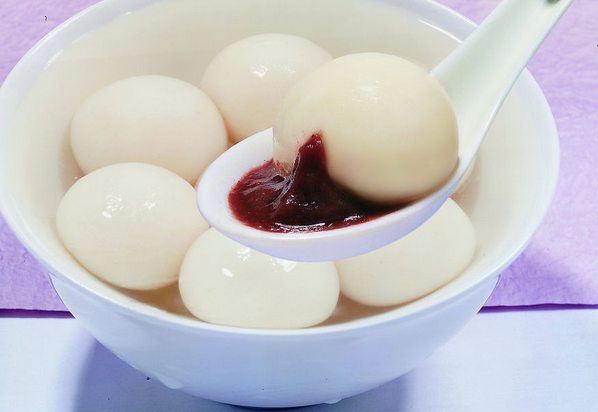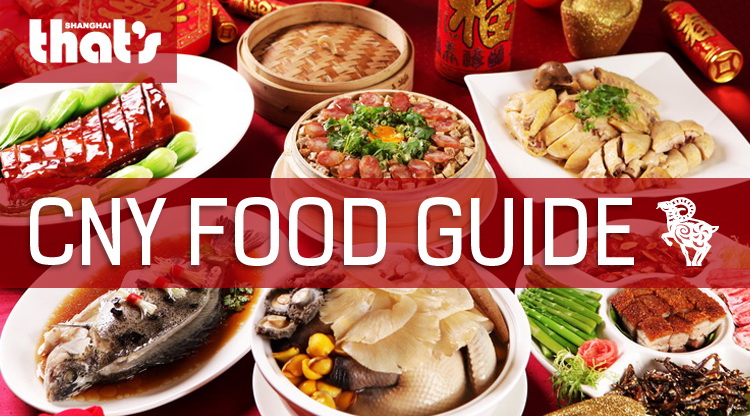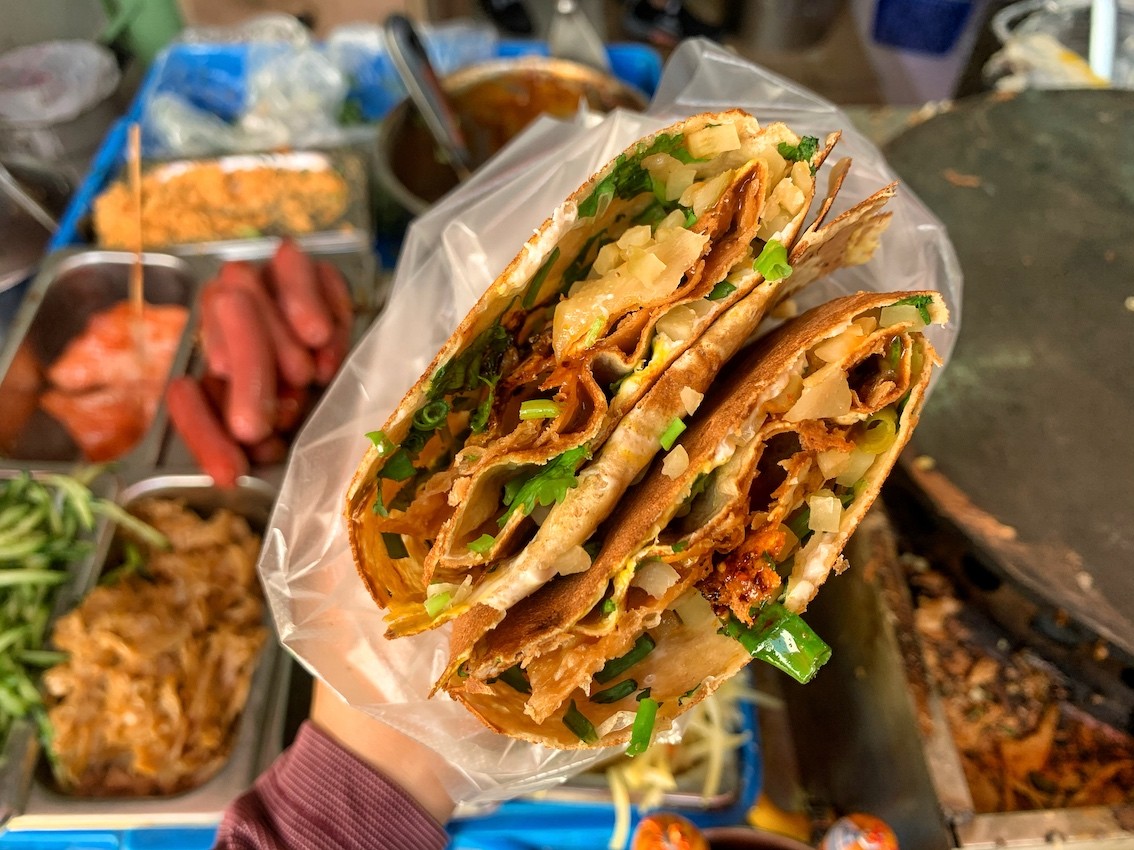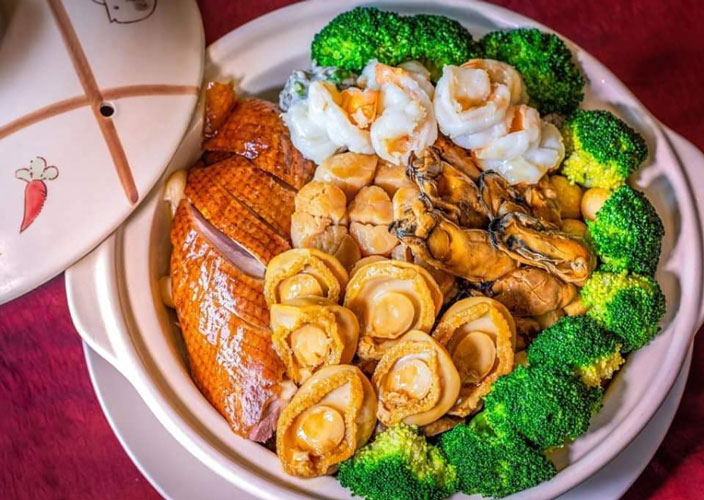Well, well, well, it’s time for Chinese New Year once again. Intrigued but mystified by this most important of traditional Chinese holidays? We’ll lead you through the top five festive Chinese dishes, their symbolic meanings and, most importantly, the best places to try them out. With these snacks in hand, you can enjoy a happy, auspicious and prosperous New Year!
Nian gao 年糕
Nian gao, or rice cake, is made from glutinous rice and is very popular during Chinese New Year, although it can be eaten year-round. People consider eating nian gao during this time to be good luck because the name is a homophone of “higher year.” “Nian” (sticky) is identical in sound to “年,” meaning ‘year,’ while the word “gao” (cake) is identical in sound to “高,” meaning ‘high’ or ‘tall.’ As such, eating nian gao symbolizes self-improvement: raising oneself taller and doing better in the coming year.
The sticky and sweet snack is made differently in various regions of China. In Ningbo, white watermill nian gao is most popular, while in Wenzhou, brown sugar rice cakes are the most prized (it’s believed that they lead to a ‘sweetened life’). In northern regions, these sweet cakes are either steamed or fried, while in the south, there are nian gao soups and stir-fries in both sweet and savory flavors.

Where to find it:
Gui Man Long specializes in traditional Shanghai and Zhejiang cuisines, and has Grandma’s sugar nian gao (RMB15) on offer: hand-beaten, chewy, sticky and sweet.
Tangyuan 汤圆
Made from glutinous rice flour, these ball-shaped dumplings are cooked and served in boiling water, the name tangyuan in Chinese a homophone for “union.” Large or small, filled or unfilled, they are traditionally eaten during the New Year and Lantern Festival, and can also be served as a dessert at wedding banquets, Winter Solstice Festivals or any occasions symbolizing family togetherness.
Taste preferences can change between the northern and southern regions of China. Generally speaking, southern people prefer sweet fillings that usually consist of sugar, sesame, sweet bean paste, osmanthus flowers or sweetened tangerine peel. In the north, people prefer salty fillings like minced meat and vegetables. In Shanghai, however, both fillings are eaten. Which style is better? You decide.

Where to find it:
Meixin dim sum store, a classic brand known for their sesame tangyuan (RMB21/two dozen), meat tangyuan (RMB21/a dozen), salty tangyuan (RMB7/four) and sweet tangyuan (RMB7/eight).
Jiaozi 饺子
Perhaps the most famous food associated with Chinese New Year, jiaozi dumplings are believed to bring prosperity, thanks to the fact that they look like the gold ingots (yuan bao) used as currency during the Ming Dynasty. The name also sounds like the word for the earliest paper money. Many families eat jiaozi on Chinese New Year’s Eve or on the first day of the year because it’s a homophone of “交子” (jiaozi), referring to the intersecting moment between the old year and the new; eating them is believed to bring good fortune to the household.
Consisting of ground meat and/or vegetables, jiaozi can be cooked in boiling water, steamed or fried to a golden crisp. In northern parts of the country, these horn-shaped treats are eaten year-round as a main course.

Where to find it:
A must-have in most northeastern restaurants, various hand-made dumplings are on offer in Dongbei Jiao Zi Wang, including cabbage dumplings (RMB15), beef dumplings (RMB18, 150g), celery & meat dumplings (RMB15, 150g).
Eight-treasure Rice 八宝饭 (ba bao fan)
Usually served as the last dessert for a New Year’s Eve dinner, eight-treasure rice is especially popular in the south, and is made from glutinous rice steamed and mixed with lard, sugar and eight kinds of fruits or nuts. These can include red dates, lotus seeds, longan, raisins, walnuts, peanuts and more.
Each ingredient of the colorful and sweet dessert has its own meaning. The lotus seeds represent a harmonious married life, longan signifies reunion, red dates are wishes to have a healthy baby, pumpkin seeds mean ‘safe and sound’ and other preserved fruits symbolize life going smoothly. Although the ingredients have gradually become simpler over time, the basics of this auspicious dish have remained the same for generations.

Where to find it:
Shanghai Min, an old Shanghainese restaurant that has this sweet, soft and glutinous rice pudding (RMB22) on offer.
// See Listing Here
Poon choi 盆菜
This Cantonese dish was first made in a Hong Kong fishing village during the Song Dynasty (970-1279). Legend has it that, to serve the young Emperor and his army who fled to the south during battles against invading Mongol troops, locals collected the best ingredients available and cooked them all together in wooden washbasins, since during wartime there were not enough conventional pots and pans. Thus poon choi was invented, usually served in large wooden, porcelain or metal basins due to its size and communal consumption.
Consisting of a variety of ingredients like pork, beef, lamb, chicken, duck, abalone, ginseng, shark fin, fish maw, prawns, crabs, fishballs, squid, dried shrimp, crispy pigskin, beancurd and Chinese radish, this hearty dish is a unique combination served whenever there are rituals, weddings, festivals and other celebrating occasions.
.jpg)
Where to find it:
This traditional Hong Kong dish is available at The Peninsula hotel’s Yi Long Court restaurant from February 2 to March 5 (RMB828-RMB3,888 +15 percent service change). Featuring prickly sea cucumber, Australian dried abalone, oysters and much more, this iconic dish for sharing will be served in two portion sizes, the larger “Fortune and Fame,” and smaller “Fortune and Treasure.”
CNY Dinner Events:
.jpg)
 Buffet in Marriott Café
Buffet in Marriott Café
Celebrate the New Year in lavish buffet style. Marriott Café at the Shanghai Marriott Hongqiao is offering a New Year-themed grand buffet with an extensive selection of traditional Chinese cuisines, highlighting dumplings, roasted suckling pigs, Peking roast duck and more. Book early to get discounts of up to 50 percent off. Lunch buffet: RMB188/person; dinner buffet RMB248/person (prices subject to 15 percent service charge).

.png) Tailored CNY dishes at Wan Hao
Tailored CNY dishes at Wan Hao
Enjoy an opulent and warm reunion dinner at Wan Hao Chinese restaurant at JW Marriott Hotel, prepared by Chinese Executive Chef Kevin Ji and his culinary team. Options range from RMB1,888 for tables of three people, up to RMB8,888 for a table of 10 and a more extravagant feast. Reservations for dinner are available from Feb 18 to 28, prices subject to 15 percent service charge.
 Fine Dining at No.55
Fine Dining at No.55
The No.55 Chinese restaurant at Hotel Massenet in the historic Sinan Mansion has prepared Chinese New Year’s Eve dinners (RMB5,688-6,888 per table) with a selection of local and Cantonese dishes, highlighting stewed abalone, secret-recipe chicken, braised sea grouper and more. Poon Choi gift boxes (RMB688/RMB1,588) are also available to bring home for a hearty festive dinner.
Yi Feng Court Cooking Show

.png) Fancy getting out of town for the holidays? Yi Feng Court at the Fairmont Yangcheng Lake hotel in nearby Jiangsu Province invites guests to a special live cooking show, where head chef Lucky Guo and his team will present a variety of auspicious dishes at 3pm everyday from Feb 19 to 23. Free for hotel guests.
Fancy getting out of town for the holidays? Yi Feng Court at the Fairmont Yangcheng Lake hotel in nearby Jiangsu Province invites guests to a special live cooking show, where head chef Lucky Guo and his team will present a variety of auspicious dishes at 3pm everyday from Feb 19 to 23. Free for hotel guests.
// See Listing Here, yangchenglake@faimont.com)
Reunion at Yi Café

 Yi Café in the Pudong Shangri-La hotel has an enormous authentic Chinese New Year buffet, with a twist of international flavors too. Packed with festive family fun, the restaurant will have paper and sugar printing sessions for kids, accompanied by live Chinese zither, piano and violin performances. RMB528 per person inclusive free flow of beer, rice wine and soft drinks; RMB265 for children between 6-11 years old and free for under 6’s. February 18, starting from 5.30pm onwards.
Yi Café in the Pudong Shangri-La hotel has an enormous authentic Chinese New Year buffet, with a twist of international flavors too. Packed with festive family fun, the restaurant will have paper and sugar printing sessions for kids, accompanied by live Chinese zither, piano and violin performances. RMB528 per person inclusive free flow of beer, rice wine and soft drinks; RMB265 for children between 6-11 years old and free for under 6’s. February 18, starting from 5.30pm onwards.
.png) Hai Pai Blessings
Hai Pai Blessings
Enjoy an abundant and warmhearted Chinese New Year Eve dinner at modern and bright Hai Pai restaurant or Garden Studios at Andaz Xintiandi. Starting from RMB388 per person and you get customized menus with special dishes presented by Johnny Xiang, Chef de Cuisine of Hai Pai, which features creative offerings include braised lamb, steamed soon-hock fish, wok-fried jumbo prawns and festive spring dessert selections.






















0 User Comments